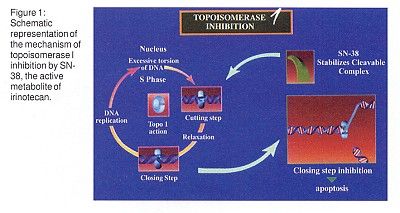Irinotecan Is Bioactivated in Liver and Intestine to Topoisomerase I Inhibitor
SAN ANTONIO, Texas-Irinotecan is metabolized via CYP3A4 to the less active oxidative metabolites APC and NPC and is bioactivated in the liver and intestine by human carboxylesterases (hCE) to the topoisomerase I inhibitor SN-38 (Figure 1). The pharmacology of irinotecan (Camptosar, CPT-11), a water-soluble, semisynthetic derivative of camptothecin, was reviewed at the Vanderbilt University Symposium by John G. Kuhn, PharmD, of the Departments of Medicine and Pharmacology, University of Texas Health Science Center, San Antonio, and College of Pharmacy, University of Texas.
SAN ANTONIO, TexasIrinotecan is metabolized via CYP3A4 to the less active oxidative metabolites APC and NPC and is bioactivated in the liver and intestine by human carboxylesterases (hCE) to the topoisomerase I inhibitor SN-38 (Figure 1). The pharmacology of irinotecan (Camptosar, CPT-11), a water-soluble, semisynthetic derivative of camptothecin, was reviewed at the Vanderbilt University Symposium by John G. Kuhn, PharmD, of the Departments of Medicine and Pharmacology, University of Texas Health Science Center, San Antonio, and College of Pharmacy, University of Texas.

"The carbamate prodrug irinotecan and its metabolites are in reversible pH/protein-dependent equilibrium with their active lactone and inactive hydroxy acid forms, with an average irinotecan lactone area under the concentration-time curve (AUC)/total AUC IV of 37%," Dr. Kuhn said. The average SN-38 lactone/total AUC IV is 55%. The similar ratio for topotecan (Hycamtin) is 33%.
Converting to Active Form
"Carboxylesterase 2 in the liver is important for the conversion of irinotecan to the active SN-38 form, which is 94% bound to albumin," Dr. Kuhn said. SN-38 (and bilirubin) are conjugated by UGT1A1. Dr. Kuhn said that polymorphisms of UGT1A1 are common and that severe toxicity has been observed in patients with deficient UGT1A1 (Gilbert’s syndrome).
"Patients with the 7/7 polymorphism in glucuronidation of SN-38 can expect to have a 50% increase in SN-38 levels. Those with the 6/7 polymorphism can expect a 25% increase in SN-38. In such patients I would think about using a lower starting dose of irinotecan, then dose escalating," Dr. Kuhn said.
MRP2 is one of the liver export pumps responsible for biliary transport and removal of open forms of irinotecan/SN-38 and of closed and open forms of SN-38G. Inhibitors of MRP2 include cyclosporin and probenecid.
Dr. Kuhn emphasized the importance of hepatic elimination of irinotecan. "In patients with elevation of bilirubin, there is a lower clearance of CPT-11, compared to normal subjects. Elevated transaminases appear to have no effect on clearance of irinotecan. The driver in irinotecan clearance appears to be bilirubin," he said.
Oral Administration Tested
Oral irinotecan had significant activity in human tumor xenografts, so Dr. Kuhn and colleagues tested oral administration of the intravenous formulation. (Oral formulations are not available in the United States, although investigational formulations have been tested in clinical studies.)
"Because the first patient complained of bitterness, we were worried about development of anticipatory nausea and vomiting. To prevent that, we mixed the IV irinotecan with various beverages. We found that stability was excellent in CranGrape juice but not with CocaCola or other drinks, so a CranGrape mixture (IV dose diluted in 50 mL D5W) was used in the study," he said.
The maximum tolerated dose was 66 mg/m2/d. Dose-limiting toxicity was diarrhea, similar to that seen with IV administration. The lactone to total AUC ratio for irinotecan was similar with the oral and IV forms (36% vs 37%), and the ratio for SN-38 was 73% with the oral dose vs 55% with the IV dose. The SN-38 AUC dose exposure at the MTD was 330 mg • hr/mL with the oral formulation. Dr. Kuhn reported that oral irinotecan was rapidly absorbed, with a Tmax of 1 hour.
Combination Regimens
Dr. Kuhn also reviewed pharmacokinetics and pharmacodynamic data from trials of irinotecan used in combination regimens. There were no sequence-dependent side effects or kinetic alterations between irinotecan and cisplatin.
No pharmacokinetics effects were reported for docetaxel followed by irinotecan or for paclitaxel (Taxol). Mitomycin-C (Mutamycin) followed 24 hours later by irinotecan had no pharmacokinetics effects, but mitomycin-C increased topoisomerase I gene expression," he said.
"A recent provocative study showed that 1 µg/mL of SN-38, which is not a clinically achievable level, used in colorectal cancer cell lines induced an increase in NFkB," Dr. Kuhn said. He suggested that this might be a mechanism of chemoresistance and that future studies should test combinations of irinotecan with cyclooxygenase-2 (COX-2) inhibitors, which block NFkB.